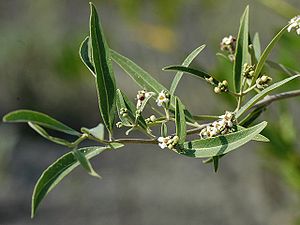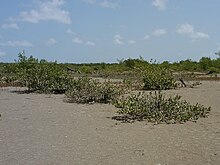Avicennia
| Avicennia | ||||||||||||
|---|---|---|---|---|---|---|---|---|---|---|---|---|

Black Mangrove ( Avicennia germinans ) blooming branch |
||||||||||||
| Systematics | ||||||||||||
|
||||||||||||
| Scientific name of the subfamily | ||||||||||||
| Avicennioideae | ||||||||||||
| Miers | ||||||||||||
| Scientific name of the genus | ||||||||||||
| Avicennia | ||||||||||||
| L. |
Avicennia is the only genus of plants of the subfamily Avicennioideae within the Acanthus family (Acanthaceae).
The species of the genus Avicennia are next to the not closely related taxa of the tribe Rhizophoreae in the family of Rhizophoraceae the most important mangrove trees . They occur in the area of influence of the tides of tropical and subtropical coasts on all continents. The American-West African species Avicennia germinans is sometimes referred to as the black mangrove, the Indo-Pacific Avicennia marina also as the gray or white mangrove; However, the name White Mangrove is mainly used for the species Laguncularia racemosa ( wing seed family , Combretaceae), which is not related to Avicennia .
description






Vegetative characteristics
Avicennia species grow as trees or shrubs under the influence of the tides. The plants reach heights of growth of more than 30 meters. The respiratory roots ( pneumatophores ), which grow vertically upwards from the underground root system and pierce the soil surface, are characteristic. Through air-permeable pores in the cortex of the respiratory roots, oxygen-rich air can reach the undersupplied, subterranean areas of the root system via a spongy air tissue ( aerenchyma ).
The timber of Avicennia shows ring structures represented by abnormal secondary growth occur. These rings do not correspond to the annual rings of trees in temperate latitudes. The cambium ring forms xylem on its inside and parenchymal cells on the outside . One to three rows of cells within the outermost parenchyma cells form a ring of sclereids , which is also one to three rows thick. The cambium stops working after a certain time, and phloem cells differentiate in the parenchyma area within the scleroid ring . Then a new cambium ring forms outside of the scleral ring. The branches are round in cross-section, young branches are sometimes square.
The opposite arranged, stalked leaves are undivided and with entire margins. On the underside of the leaf, they are densely covered with microscopic hairs. The upper side of the leaf bears salt glands that regulate the salt content of the leaf tissue.
Generative characteristics
The terminal ährigen or capitate inflorescences carry dekussiert standing flowers couples. Each flower has a very small, arched bract and two scale-shaped bracts .
The sessile, small flowers are four or five-fold and have a double flower envelope . The five sepals are briefly cupped at the base, the calyx lobes overlap laterally. Bracts, bracts and sepals remain until the fruit is ripe. The whitish or yellowish-reddish petals are fused in the lower area to a slightly zygomorphic , bell-shaped corolla tube; the upper of the four (in some cases five) corolla lobes is often wider than the rest. There is only one circle with four stamens that start in the upper area of the corolla tube. The four carpels have grown together to form an upper ovary. Inside it has four hanging ovules , only one of which develops. The flowers are rich in nectar and are pollinated by insects.
The fruits are considered by some authors as leathery capsule fruits , by others as achenes . The seeds develop still at the mother tree seedlings , but they remain in the fruit, which soon bursts open after dropping and the buoyant seedling releases ( "crypto vivipar " hidden-viviparous).

Systematics and distribution
The genus Avicennia was 1753 by Linnaeus in Species Plantarum , 1, pp 110-111 with the type species Avicennia officinalis L. positioned. The generic name Avicennia honors the Persian doctor, philosopher and polymath Avicenna , who was actually called Alij al-Husain Ibn Sina (approx. 980-1037).
The systematic position of Avicennia was long disputed. Traditionally, the genus was classified in the verbena family (Verbenaceae), but most recently it was regarded as a separate family Avicenniaceae. More recent, molecular genetic studies place Avicennia in the relationship of the acanthus family sensu lato , but confirm the monophyly of the group. According to APWebsite , Avicennia is the only genus of the subfamily Avicennioideae within the family of the acanthus plants (Acanthaceae).
The genus Avicennia includes 8 (to 14) species:
- Avicennia alba flower : Indo-Pacific from India to Northern Australia . In the Malay language the species is known as api api , whichmeans "fire" inthe Bajau language; an indication of the fact that schools of fireflies oftengatherin the trees.
- Avicennia bicolor stand. : It iswidespreadfrom the Mexican state of Chiapas , through Guatemala , Honduras , El Salvador , Nicaragua , Costa Rica to Panama .
- Black mangrove ( Avicennia germinans (L.) Stearn , Syn .: Syn . : Avicennia africana P.Beauv. , Avicennia nitida Jacq. ): It is widespread from North , Central and South America from the Bahamas to Northeast Brazil and also comes from tropical West to Central Africa .
- Avicennia integra N.C. Duke It was first described from northern Australia.
-
Avicennia marina (Forssk.) Vierh. : There are three varieties. They occur in the Indo-Pacific region , from South Africa and the Comoros north to the Sinai , inadditionin China , Japan , Hong Kong and Taiwan , south to Australia , New Caledonia and the Solomon Islands :
- Avicennia marina var. Australasica (Valeton) J.Everett (Syn .: Avicennia marina var. Australasica (Walp.) Moldenke , Avicennia marina var. Resinifera (G.Forst.) Bakh. , Avicennia resinifera G.Forst. , Avicennia tomentosa var . australasica Walp. , Avicennia marina subsp. australasica (Walp.) J. Everett )
- Avicennia marina var. Eucalyptifolia (Val.) NCDuke (Syn .: Avicennia eucalyptifolia (Valeton) Zipp. Ex Moldenke , Avicennia marina subsp. Eucalyptifolia (Valeton) J.Everett , Avicennia officinalis var. Eucalyptifolia Valeton )
- Avicennia marina (Forssk.) Vierh. var. marina
- Avicennia officinalis L.
- Avicennia rumphiana Hallier f. (Syn .: Avicennia lanata Ridl. )
- Avicennia schaueriana Stapf & Leechm. ex Moldenke
A number of synonyms exist for the named species names ; some forms of the very variable Avicennia marina have been described as separate species.
swell
- Acanthaceae with the subfamily Avicennioideae on the AP website. (Section systematics)
- Andrea E. Schwarzbach, Lucinda A. McDade: Phylogenetic relationships of the mangrove family Avicenniaceae based on chloroplast and nuclear ribosomal DNA sequences. In: Systematic Botany , Volume 27, Issue 1, 2002, pp. 84-98. doi : 10.1043 / 0363-6445-27.1.84
- Xinnian Li, Norman C. Duke, Yuchen Yang, Lishi Huang, Yuxiang Zhu, Zhang Zhang, Renchao Zhou, Cairong Zhong, Yelin Huang, Suhua Shi: Re-Evaluation of Phylogenetic Relationships among Species of the Mangrove Genus Avicennia from Indo-West Pacific Based on multilocus analyzes. In: PLOS One , October 7, 2016. doi : 10.1371 / journal.pone.0164453
- Shou-liang Chen, Michael G. Gilbert: Verbenaceae. : Avicennia marina , p. 49 - online with the same text as the printed work. , In: Wu Zheng-yi, Peter H. Raven (Eds.): Flora of China , Volume 17 - Verbenaceae through Solanaceae , Science Press and Missouri Botanical Garden Press, Beijing and St. Louis, 1994, ISBN 0-915279-24 -X . (Section description)
- NC Duke: A systematic revision of the mangrove genus Avicennia (Avicenniaceae) in Australasia. In: Australian Systematic Botany , Volume 4, 1991, pp. 229-334.
- PB Tomlinson: The Botany of Mangroves , Cambridge University Press, Cambridge 1986, ISBN 0-521-46675-X . 419 pages .: Google-Book-Online.
Individual evidence
- ↑ a b c d e f g h i j k l m n Xinnian Li, Norman C. Duke, Yuchen Yang, Lishi Huang, Yuxiang Zhu, Zhang Zhang, Renchao Zhou, Cairong Zhong, Yelin Huang, Suhua Shi: Re-Evaluation of Phylogenetic Relationships among Species of the Mangrove Genus Avicennia from Indo-West Pacific Based on Multilocus Analyzes. In: PLOS One , October 7, 2016. doi : 10.1371 / journal.pone.0164453
- ↑ E. Zamski: The mode of secondary growth and the three-dimensional structure of the phloem in Avicennia. In: Botanical Gazette , Volume 140, 1979, pp. 67-76.
- ↑ Lotte Burkhardt: Directory of eponymous plant names. Botanic Garden and Botanical Museum Berlin, Free University Berlin Berlin 2016, ISBN 978-3-946292-10-4 . doi : 10.3372 / epolist2016
- ↑ Peter Schütt, Horst Weisgerber, Hans J. Schuck, Ulla Lang, Bernd Stimm, Andreas Roloff: Trees of the tropics . Nikol, Hamburg 2004, ISBN 3-933203-79-1 .
- ↑ Api-api Putih ( Avicennia alba ) - The Tide Chaser ; Accessed July 28, 2012
- ^ A b c Avicennia in the Germplasm Resources Information Network (GRIN), USDA , ARS , National Genetic Resources Program. National Germplasm Resources Laboratory, Beltsville, Maryland. Retrieved December 27, 2017.


